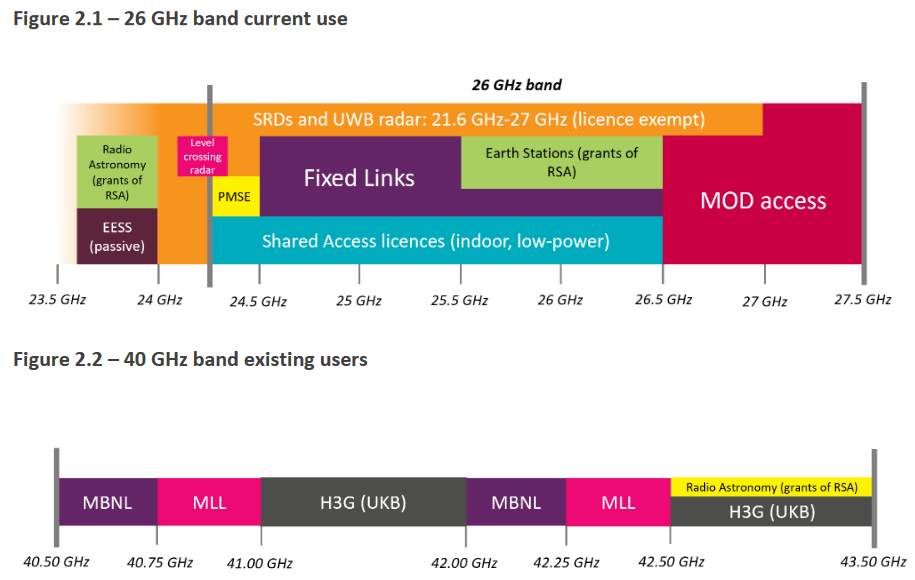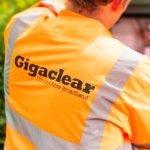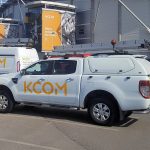Ofcom UK to Open 26GHz and 40GHz Bands for Faster 5G Mobile

The UK telecoms regulator, Ofcom, has today confirmed that they will release a large chunk of millimetre wave (mmWave) radio spectrum frequency across the 26GHz and 40GHz bands for use by ultrafast 5G (mobile broadband) technology, which could potentially make multi-gigabit mobile data speeds a reality.
So far, Ofcom has already released (auctioned) various 5G friendly mobile bands between 700MHz and 3.8GHz to EE (BT), O2 (VMO2), Vodafone and Three UK. This reflects the same sort of bands that mobile operators have been harnessing since the advent of the first 3G and 4G mobile data networks some years ago.
Naturally, the more spectrum frequency that an operator can access, the more data it can push to customers at faster speeds. The higher frequencies (26GHz and 40GHz) are thus attractive because they provide lots of extra spectrum frequency for data to be sent and received at extremely fast speeds (e.g. multi-Gigabit performance is easier), but signals are very easily disrupted (weak) and can only travel a short distance in a mobile environment.
Advertisement
In other words, the mmW bands being talked about above are more useful when serving densely populated areas (e.g. city shopping malls, airports, events etc.) and for supporting fixed wireless access (FWA) style broadband links to specific homes and businesses. But they won’t do much, if anything, to expand overall geographic network coverage.

Ofcom generally expects to award citywide licences to use mmWave spectrum by auction and assign licenses for more localised licences on a first come, first served basis, using their Shared Access licensing framework.
Ofcom’s Decision
We are enabling opportunities to access mmWave spectrum across the country for a variety of new uses. In this document, we set out how we will allocate mmWave spectrum to best support new uses:
• In the major towns and cities, where we expect the highest volume of mmWave deployment (“high density areas”), we will assign local licences on a first come, first served basis, using our Shared Access licensing framework; and award city/townwide licences by auction.
• Elsewhere in the UK (“low density areas”), we expect deployments to be sparser, and so we will assign local licences on a first come, first served basis for mmWave spectrum, using our Shared Access licensing framework.
To do this, we first need to clear the incumbent fixed wireless links which will not be able to coexist with mobile technology in this spectrum. We have therefore decided to start the statutory process to revoke:
• licences authorising fixed links in the 26 GHz band which are likely to receive harmful interference from new uses; and
• all of the existing block assigned licences in the 40 GHz band.
We note that the decisions and proposals set out in this document are subject to the outcome of these statutory processes for revoking existing licences.
We are now consulting on proposals for the design of the auction for citywide licences, the licence conditions for citywide and local mmWave licences and how we will coordinate users of this spectrum
In regard to Ofcom revoking licences authorising fixed links in the 26GHz band that are likely to receive harmful interference from new uses, Ofcom said they would begin this process later in 2023, once they have determined which fixed links are likely to receive interference from new users.
Advertisement
The fact that Three UK, which is one of the four major mobile operators, already holds a block of the 40GHz band (as does MBNL and MLL Limited) could potentially create some competition concerns – assuming Ofcom does enable them to harness it for 5G, without revoking and re-releasing it first. The regulator warns that it “might be appropriate to impose a competition measure such as a ‘precautionary cap’ to prevent H3G from acquiring large amounts of 26GHz.”
Historically, mobile operators have almost always tended to clash over spectrum auctions, which often ends up triggering legal threats and delays to the auction process. We’re not yet sure if the same will become true for the tricky mmW bands, but it’s certainly possible, even though we suspect they might be regarded by operators with a lower importance level than the 5G bands that have already been released.
The regulator is inviting responses to today’s consultation by 22nd May 2023.
Mark is a professional technology writer, IT consultant and computer engineer from Dorset (England), he also founded ISPreview in 1999 and enjoys analysing the latest telecoms and broadband developments. Find me on X (Twitter), Mastodon, Facebook, BlueSky, Threads.net and Linkedin.
« Virgin Media O2 UK Users Get Free Early Access to Diablo IV Beta
Full Fibre UK Broadband ISP Zzoomm Tops 10,000 Customers »






















































Welcome if belated news, we are far behind the USA with mmWave deployment
Not just the USA but also China and Japan to name two other countries that are using it as part of their own 5G rollout.
Indeed most of Europe has too according to this article:
https://www.notebookcheck.net/5G-mmWave-connectivity-is-finally-making-its-way-Europe-wide-with-promises-of-Gigabit-speeds.548139.0.html
It’s good that it’s being rolled out as part of 5G as in places such as shopping malls, airports, railway stations, colleges etc where there is a large footprint of people as it’s those places that will benefit the most from it.
Of course, the only downside to it is the various phone manufacturers now have to ensure that their devices support it which they might than limit to their more upmarket devices eg Samsung S22 or iPhone 14 etc.
Cue the 5G protestors, once the realise that forthcoming 5G installs are mmW (rather than repurposing existing frequencies or use frequencies that are proximate to WiFi frequencies and other in use technologies
Here’s hoping Three deploys it sooner rather than later! Just got 0.6Mb download on their 5G network!
It isn’t for supplying broadband for home users, it’s about higher bandwidth coverage for large covered areas like stadiums, shopping centres, Train Stations, Airports, etc. 26Ghz and 40Ghz wont penetrate a brick wall, even tree’s would disrupt the signal, and heavy rain would attenuate the signal to the point of making it unusable.
The top end of the SHF Band and anywhere in the EHF Band are purely line of sight, although coverage could be extended through reflection or passive repeaters, but the frequencies aren’t suitable for long distance outdoor mobile coverage.
As the article says, you could use it for a fixed wireless access style point-to-point deployment, using an external antenna. This is not a new idea.
That’s unfortunate as I get a solid speed of between 600-700mbs constantly on my three 5g Hub. Hence the move from expensive VM
“As the article says, you could use it for a fixed wireless access style point-to-point deployment, using an external antenna. This is not a new idea.”
They could, but 26Ghz and 40Ghz are pretty sensitive to rain fade and need direct line of sight. Because of the sensitivity to rain, link budgets would have to be generous both ways and a lot of factors would affect quality. Lower frequencies are easier to use and don’t require external antenna’s, and are less affected by bad weather. I suppose time will tell if providers purchase 26Ghz and 40Ghz bands for FWA.
There is already such thing actually, in Italy Fastweb Air has been live for a while.
Uses 26GHz to deliver up to 1Gb/200Mb, anchoring on partner’s LTE B42 OpNet.
Another italian provider, Eolo, has got the largest network but based on Intracom Telecom 28GHz solution and offers up to 200M/50M.
I’ve never heard of those companies, but the feasibility of using FWA at 26Ghz or 40Ghz, for a particular area, will depend on the local geography, number of users, distance, etc. There could be some interesting solutions to eliminate conventional line of sight issues, maybe using HAPS to give a wide area coverage and utilising various Frequency bands, with Frequency diversity used to compensate for bad weather conditions and other atmospheric anomalies.
You can achieve almost anything, if you throw enough money at it, but the provider will have to pass any extra cost onto the customer.
Of course it depends on the money you want to spend, but yeah I wanted to report that there are already deployments in continental Europe. Sticking strictly to Fastweb, which is the only proper 5G deployment, their concern is really low cost, because the italian market has a very low demand if prices are higher than ~ 30€ a month.
The installation must have LOS, otherwise is simply KO. It works up to about 1km from the mast and speeds are actually quite good, apart from latencies which are dependent on the LTE part of course (they have a plan to migrate B42 to N78 SA in the works though). Vendors are Huawei/Ericsson/ZTE, masts are not an issue due to how italian laws work (there’s a lot more than in the UK, because mid bands for 2G/4G are limited to 6V/m in electric field emission, instead of 60V in the UK I believe; also access is not a problem because if the existing mast is only accessible via third parties, law says they must grant access no question asked).
Its all about generating money
The fact that no one in the comments knows that current devices do not have the hardware required for this and therefore won’t even be able to use it is astonishing.
The 26GHz band (n258) is supported by the US versions of the iPhone 14 and Galaxy S23 line-ups. Granted that’s still not accessible to most but there are devices starting to support these frequencies.
No devices in the UK support mmWave because no network currently supports mmWave. That will change one it’s deployed.
Wow, aren’t you the only person with a working brain?
Here, have a cookie.